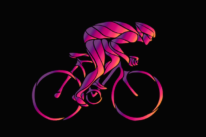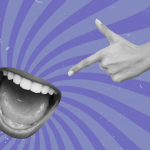
“The secret of living well and longer is: eat half, walk double, laugh triple, and love without measure.” ~Tibetan Proverb
For a lot of my life, my weight was a source of great stress.
Growing up, I was the frequently taunted chubby kid in class. Unlike my sister, who always chose strawberry-flavored everything, I leaned toward chocolate and spent way too much time sitting in front of a TV.
I had a potbelly (which made me look like a pregnant eight-year-old) that only slightly deflated when a growth spurt shot me up to the towering height of 5’1½”.
In my adolescence, teens, and early twenties, I struggled with bulimia—a misguided attempt to reclaim my self-esteem through thinness and control the only thing I felt I could control, my weight.
In the years since I recovered, I’ve learned to value my body, not just for how it looks but also for what it does for me, and to take good care of it.
When we take care of our bodies, we feel stronger, more energized, and more capable. We breathe and sleep better. We decrease our risk of developing certain diseases, increase our life span, and improve our mood and focus.
We also open ourselves up to a world of possibilities. When you’re fit, you’re free to weigh your options based on what excites you, not based on your physical limitations.
Rock climbing sound interesting? You can give it a try and see! Considering a dance class? Why not! Dreaming of doing a marathon or walking tours through your favorite European cities? Sure, you can handle it!
There’s little more liberating than knowing that you can do what you want to do—that you have the strength, energy, and stamina to experience something that may blow your hair back and make you feel exhilarated and alive.
That’s what being fit does for us. And that’s why I now do my best to move every day, and also to eat a mostly healthy diet.
Since this is a popular month for implementing a new exercise plan, I thought it would be the perfect time to share some of my own fitness practices. Perhaps one or more of these will help you get moving and get (or stay) in shape.
1. Get your 10,000 steps without leaving your living room.
I first learned about the benefits of walking 10,000 daily steps—the default goal for Fitbit users—back when I worked in mobile marketing. As part of a promotion for pedometers, a team of us covered the country on foot over a three-month period.
Prior to that time, it had never occurred to me that walking was a viable way to stay fit and healthy (or that it could be fun and exciting). It just seemed too low impact to count as exercise—but count it does!
Not only does walking improve our overall health and decrease our risk of heart disease, it can also boost our mood and energy and reduce stress, since it has a meditative quality.
While I prefer to walk outside, since I find it calming to be in nature and enjoy seeing the houses in my neighborhood, there are days when I just can’t make it happen. On those occasions, I find short bursts of time throughout my day to walk in place.
Most often I’ll do this while working on my laptop or watching a show, if it’s the end of the night and I’m unlikely to do anything else. Is it the best workout in the world? No. But it’s something, and something is always better than nothing. That leads me to my next suggestion…
2. Give yourself permission to do an incredibly short workout.
If you’re an all-or-nothing person, like me, you may feel like it’s not worth going to the gym unless you’re going to do a full workout, whatever that looks like for you.
For me, that would include at least thirty minutes on an elliptical, weights, crunches, and a couple of leg machines. But there are some days when I don’t have the time or energy to do all of those things.
Recently I’ve been telling myself it’s okay to do fifteen minutes on the elliptical and crunches, and call it a day. Oftentimes I end up doing more than that, but giving myself permission to do the bare minimum helps get me out the door.
3. Pair exercises with daily activities.
I know this might seem like an odd recommendation from someone who promotes mindfulness, but I have found it very effective to multitask certain activities that I do daily. For example, I usually do squats while drying my hair.
This ensures I do multiple reps, since I have several minutes to work with, and also decreases the likelihood that I’ll forget to do my squats, since I’ve linked them to an activity I do every day, without fail.
Some other ideas to consider:
- Before putting your Swiffer or broom back, use it as an oblique bar and do a set or two of ab twists.
- Before cooking, use cans, bottles, bags of rice, or other food items as weights; hold one in each hand and lift your arms out to the side twenty-five times.
- If you have stairs in your home, every time you need to go up, come down and go back up again, doubling your steps climbed.
- Do leg lifts or squats while brushing your teeth.
4. Look into a standing desk.
Whether you work from home, like I do, or do any kind of computer work in the evening, a standing desk ensures you spend less time sitting. And as they say, sitting is the new smoking. No, I didn’t make that up. “They” really do say it!
We’re spending far more time sitting than ever before, between driving, working in offices, and binge watching Netflix at night; and it’s increasing our risk of developing a host of different illnesses, such as cancer, heart disease, and Type 2 diabetes.
If you can’t afford to buy a standing desk, you can easily make your own by piling a bunch of boxes on your dining room table and placing your laptop on top.
I use this same set up when exercising on a portable elliptical machine—a small piece of equipment that cost me about $100, takes up very little space, and offers a nice alternative to walking in place.
5. Trade your office chair for a stability ball.
You may or may not be able to do this at work, but at the very least, you can consider this a viable alternative to a standing desk at home.
Sitting on exercise ball ensures you keep your spine long, since that’s crucial for balancing, and it also tones your core. Experts recommend using a stability ball in place of a chair for twenty to thirty minute increments, since sitting on a ball puts increased load on your lower spine.
If you’re anything like me, you may also prefer using a stability ball for crunches to lying on the ground. You work more core muscles balancing on a ball, and it’s a lot easier on your spine, since it’s soft.
6. Combine exercise and stress relief.
When I first found yoga in my mid-twenties, I quickly got hooked. After every class I left feeling dramatically calmer, less anxious, and more at peace with myself. And the benefits of class bled into my daily life. When situations arose that would ordinarily cause me stress, I was able to cope with far less internal drama. When your workout simultaneously eases your mental anguish, it’s pretty easy to make it a habit.
If you think yoga could be a good fit for you, there are tons of different options to meet your individual needs, from hot yoga (far more intense) to restorative yoga (a much gentler practice). You can practice at a studio, in a gym that offers classes, or even find some videos on YouTube to try at home.
Whether you do a ninety-minute class or a ten-minute video, you’ll see benefits, and will likely get hooked!
7. Give up the good parking spots.
I always enjoy integrating easy exercise into my daily life, whether that means taking the stairs instead of the escalator or walking instead of driving.
When I’m going somewhere specific, it doesn’t feel like a chore—just a way to get from A to B. And I generally enjoy walking outside, since there’s always something around me that catches my interest.
One easy way to get a little extra exercise is to leave a little early, wherever you’re going, and park a fifteen-minute walk away. This ensures a total of a half-hour of walking. And the best part, you can’t bail on the second half—at least not if you want to get home!
8. Plank your way to a tighter core.
I loathe crunches with a passion. As I mentioned, I mind them less with a stability ball, but I don’t have one at home, since my space is limited. So on days when I don’t go to the gym, I plank to tone my core.
I started by holding the plank for just fifteen seconds, and then every couple of days increased the time by five seconds until I eventually got up to two minutes.
My stomach isn’t back to what it was before I had fibroid surgery several years back (and it may never be), but the combination of planks, oblique twists, and crunches has dramatically tightened my core.
—
I’m a big fan of mixing up my exercise routine, allowing myself lots of options—from hiking, to biking at the beach, to doing yoga or cardio at the gym, to moving in my own home—and I think that’s been the key to my consistency.
When you give yourself choices to meet your varied moods and needs, you’re far more likely to move regularly. And at the end of the day, that’s all that really matters: that you do something, every day, to get your blood pumping.
When you do this, you’re far more likely to feel strong in mind and body, good in your skin, and capable of doing whatever you want to do.
About Lori Deschene
Lori Deschene is the founder of Tiny Buddha. She’s also the author of Tiny Buddha’s Gratitude Journal, Tiny Buddha's Worry Journal, and Tiny Buddha's Inner Strength Journal and co-founder of Recreate Your Life Story, an online course that helps you let go of the past and live a life you love. For daily wisdom, join the Tiny Buddha list here. You can also follow Tiny Buddha on Facebook, Twitter, and Instagram.
- Web |
- More Posts













 Though I run this site, it is not mine. It's ours. It's not about me. It's about us. Your stories and your wisdom are just as meaningful as mine.
Though I run this site, it is not mine. It's ours. It's not about me. It's about us. Your stories and your wisdom are just as meaningful as mine. 